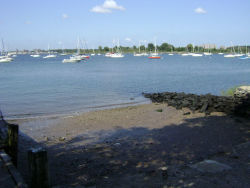City Island Wetlands
City Island Wetlands
City Island consists of 230 acres, surrounded by the Long Island Sound and Eastchester Bay. Although a bridge connects this maritime oasis to the bustling Bronx, its tranquility is guarded by its closest neighbor and New York City’s largest park, Pelham Bay.
The native Siwanoy Indians called this island Minnewit, which means “pine island.” A Dutch settler, Adrian Block, arrived in the early 1600s and initiated the first European settlement. In 1654, Thomas Pell, an Englishman, bucked the Dutch colonial authorities and became the first European to hold the deed to the entire island. Benjamin Palmer bought the island in 1761. Palmer and his fellow investors named the island New City Island, which was shortened to City Island about 100 years later. Palmer, banking on sailors’s desire to avoid the notorious Hell Gate passage into New York Harbor, hoped to make the island a port to rival Manhattan. However, all was lost when British troops raided the island during the American Revolution. City Island was not destined to be a seaport, but it would sustain a flourishing maritime economy.
By the mid-19th century, City Island’s oyster industry was booming. Clamming and fishing operations prospered as well. The Solar Salt Works opened in 1830 and sold salt removed from seawater. The island was perfect for the shipbuilding industry, because of its extensive waterfront, well-protected harbor, and deep water right off the shipyards. David Carll built the first shipyard on Pilot Street in 1862. Carll also helped build the island’s first bridge in 1873, using timbers from the battleship USS North Carolina, which was dismantled in his yard. The island’s proud shipbuilding tradition is not limited to commercial vessels; five yachts designed on City Island after World War II went on to win the America’s Cup.
In 1887, William Belden created an amusement park and resort on the island’s south end, which soon became known as Belden Point. By the turn of the century, tycoons such as Vincent Astor, J. P. Morgan, and William Randolph Hearst were traveling to the island in their palatial yachts. Tourism and trade strengthened the island’s ties to Manhattan, and in 1895 City Island opted to leave the town of Pelham and join New York City. In the past century, the island has become largely residential, and most City Islanders work in Manhattan. By 1982, the last boatyard had closed, and only a few maritime enterprises, particularly sailmakers, remain. Antique shops, art galleries, and seafood restaurants abound on City Island Avenue.
Wetlands are valuable ecosystems that can slow erosion, prevent flooding by retaining storm waters, filter and decompose pollutants, and slow global warming by converting carbon dioxide into oxygen at a prodigious rate.
The formation of wetlands can be traced back to the most recent ice age. A massive ice sheet called the Wisconsin Glacier advanced on New York City 75,000 years ago, pushing rock, soil, and boulders ahead. When the ice melted 17,000 years ago, water flowed to the sea, creating streams and rivers that carved through rock. Large glacial fragments broke off, melted, and left depressions called kettles. If layers of fine silt and clay were deposited on the bottom of the depressions, the kettles collected water and ponds formed. Where waters were shallow or flowed slowly, seeds and spores were able to take root and flourish. Generations of plants grew and decomposed, building peat-rich sediments. As wind and water eroded the soil, the steep slopes grew gentler, slowing the passage of water. Plant communities diversified under these favorable conditions, attracting animals that fed on the plants. The sophisticated food web that developed brought advanced predators to the wetlands: snapping turtles (Chelydra serpentina), wolves (Canis lupus), several species of hawks, and humans (Homo sapiens).
These wetlands lie in Eastchester Bay between William Avenue and Bay Street. Most of the land is partially underwater, and the tract contains both low and high marsh areas (Spartina alterniflora and Spartina patens), mud flats, and giant reeds (Phragmites communis). The Department of Citywide Administrative Services assigned the property to Parks in 1997.
Check out your park's Vital Signs
Clean & Safe
Green & Resilient
Empowered & Engaged Users
Share your feedback or learn more about how this park is part of a
Vital Park System

